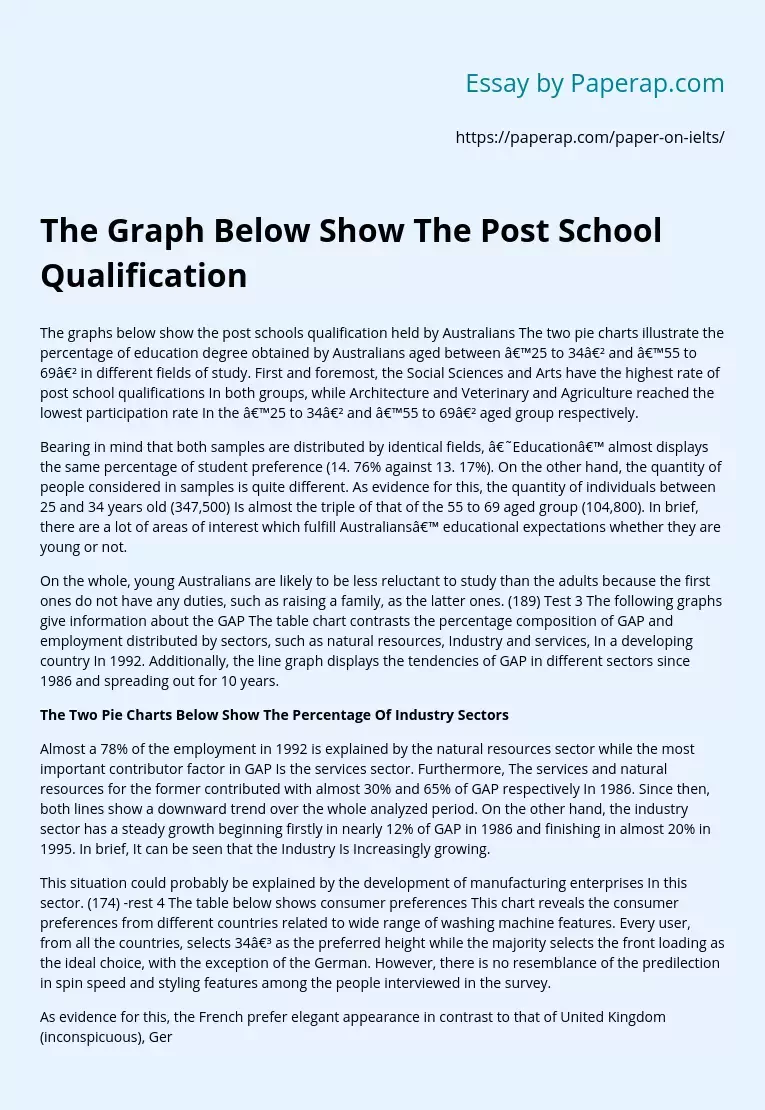The Graph Below Show The Post School Qualification
The graphs below show the post schools qualification held by Australians The two pie charts illustrate the percentage of education degree obtained by Australians aged between ’25 to 34′ and ’55 to 69′ in different fields of study. First and foremost, the Social Sciences and Arts have the highest rate of post school qualifications In both groups, while Architecture and Veterinary and Agriculture reached the lowest participation rate In the ’25 to 34′ and ’55 to 69′ aged group respectively.
Bearing in mind that both samples are distributed by identical fields, ‘Education’ almost displays the same percentage of student preference (14.
76% against 13. 17%). On the other hand, the quantity of people considered in samples is quite different. As evidence for this, the quantity of individuals between 25 and 34 years old (347,500) Is almost the triple of that of the 55 to 69 aged group (104,800). In brief, there are a lot of areas of interest which fulfill Australians’ educational expectations whether they are young or not.
On the whole, young Australians are likely to be less reluctant to study than the adults because the first ones do not have any duties, such as raising a family, as the latter ones.
(189) Test 3 The following graphs give information about the GAP The table chart contrasts the percentage composition of GAP and employment distributed by sectors, such as natural resources, Industry and services, In a developing country In 1992. Additionally, the line graph displays the tendencies of GAP in different sectors since 1986 and spreading out for 10 years.
The Two Pie Charts Below Show The Percentage Of Industry Sectors
Almost a 78% of the employment in 1992 is explained by the natural resources sector while the most important contributor factor in GAP Is the services sector.
Furthermore, The services and natural resources for the former contributed with almost 30% and 65% of GAP respectively In 1986. Since then, both lines show a downward trend over the whole analyzed period. On the other hand, the industry sector has a steady growth beginning firstly in nearly 12% of GAP in 1986 and finishing in almost 20% in 1995. In brief, It can be seen that the Industry Is Increasingly growing.
This situation could probably be explained by the development of manufacturing enterprises In this sector. (174) -rest 4 The table below shows consumer preferences This chart reveals the consumer preferences from different countries related to wide range of washing machine features. Every user, from all the countries, selects 34″ as the preferred height while the majority selects the front loading as the ideal choice, with the exception of the German. However, there is no resemblance of the predilection in spin speed and styling features among the people interviewed in the survey.
As evidence for this, the French prefer elegant appearance in contrast to that of United Kingdom (inconspicuous), German (indestructible) and Sweden (strong) people. In the other theatres, such as drum material, water heating system, capacity and washing action, the preferences are equally divided. In brief, it can be seen that German people demand the highest value in capacity, spin speed and shell dimensions. This situation could be possible explained by the quantity of member who composes the typical close German family in comparison with that of other countries. 155) -rest 5 The graphs below show the enrolment The line graph contrasts the tendency of the registration of the student body in Australian universities from 1989 and spreading out for 10 years. There are upward trends of overseas students; whose beginning shows a significant rise as well as their total has a dramatic growth. On the other hand, local students display the opposite trend, their total and commencing indicate a substantial fall and a steady fluctuation respectively. Regarding the number of students who comprises the student body, foreign students total are the minority.
As evidence for this, in 1989 there were 20,000 non-local versus 400,000 local students, so the percentage of overseas was 5% of Australians students. As for student enrolments, we can see that both overseas and local students have actors, such as accreditation, facilities or graduate placement career, in Australian universities more than the local students. (150) -rest 6 The charts below show the results of a survey of adult education The bar chart illustrates the percentage of adult’s reason preferred which encourage to study.
On the other hand, the pie chart shows the portion of studies cost which should be paid by taxpayer, individual and employer, according to the point of view of surveyed people. Among the wide range of reasons to study, interest in subject is the most popular (40%) while meeting people is the least (9%). However, there are other reasons, such as help for current Job (22%), improving prospects of promotion (20%) and enjoying learning/studying (20%), which have almost the same preference.
The Graph Below Show The Post School Qualification. (2019, Dec 05). Retrieved from https://paperap.com/paper-on-ielts/

